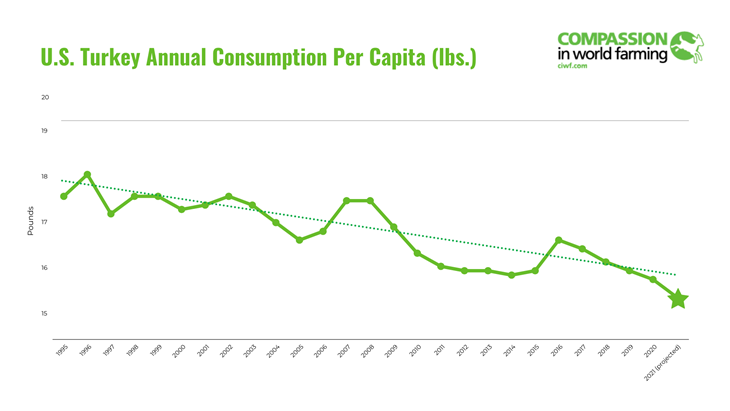11/12/2021
COVID-19 took family gatherings off the table for millions of Americans last year. For the first time in living memory, decades-old traditions were forgone and replaced with quiet reflection, scrolling through memes, or binge-watching Netflix. This year, however, as the nation cautiously unwraps a new holiday season, folks are once again calling up (or, in the unfortunate case, group texting) their family members, firing up their ovens, and of course, buying the bird.
Or are they? As more Americans become aware of industrial agriculture’s welfare, environmental, climate, public health, and social justice impacts, a new tradition of savory and slaughter-free plant-based turkey alternatives is taking hold. Considering the growing number of vegans, vegetarians, and flexitarians and data from producers, we calculate around 4.5 million plant-based turkeys are likely to be served this Thanksgiving.

The Good Food Institute’s most recent industry report states that plant-based meat dollar sales increased by 45% from 2019 to 2020, and plant-based food retail sales grew twice as fast as animal-based food sales last year. And with meat alternatives gracing mainstream national and international food chains, plant-based meat is becoming exceedingly commonplace.
As the demand for animal-free options is increasing, the demand for turkey is also falling. The national consumption rate of turkey has been steadily declining for the last 25 years, down from 17.7 pounds per capita in 1995 to 15.8 pounds per capita in 2020 (USDA). Consumption* per capita during the holiday season has decreased as well, although to a lesser extent, from 6.1 pounds in 1995 to 4.7 pounds in 2020.

These reductions are for good reason. At this year’s UN Food Systems Summit, we heard how the production of animal-sourced foods must be reduced by at least half to stay within planetary boundaries and environmental limits. In addition, the global livestock system must shift to regenerative, nature-friendly, and humane practices to reduce the overuse of natural resources, maintain biodiversity, and lower the risk of zoonotic and antibiotic-resistant diseases.
Over 280 million turkeys are raised in the U.S. each year, many in factory farming systems.

They are typically kept indoors under dim, artificial lighting their entire lives and suffer from overcrowding, extreme heat and cold, and polluted air. Turkeys in factory farms are bred to grow so unnaturally large that they struggle to walk and suffer from joint and bone disorders and foot sores. Once they reach slaughter weight, many endure broken wings and legs from rough handling and transport and from struggling before being stunned. In their final moments of life, the birds are hung upside down by their legs and dipped into electrified water. Sometimes turkeys are slaughtered by cutting their throats or dislocating their necks while they are fully conscious.
Our diets are changing with the times, and this is the year millions of Americans will take those changes to the Thanksgiving table, ushering in a new tradition of joy, conservation, and compassion.
*As per USDA convention, we use “consumption” synonymously with “disappearance”. We note that the latter term includes “waste” and “pet food” so per capita consumption figures are likely to be lower.
Behind the Number:
U.S. population estimates from the U.S. Census Popclock. Estimates of the U.S. vegan and vegetarian population based on an average from Packaged Facts and the Vegetarian Resource Group (8% and 4%, respectively). Estimates that around 33.5% of the U.S. population is flexitarian averaged from Packaged Facts and OnePoll. Popular flexitarian diets range from only eating plant-based once per week to only eating meat once per week. We conservatively assume that one in seven (13%) flexitarians will eat plant-based turkey on Thanksgiving--representing one plant-based meal per week that a minority of flexitarian diets adopt. Plant-based turkey holiday roast serving size of 6.5 people per product are the average of several brands (Tofurky, Gardein, Field Roast, and Quorn). About 85% of Americans celebrate Thanksgiving based on a YouGov poll from 2016.

